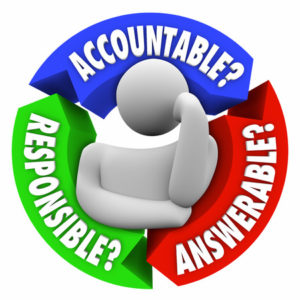By Rose O. Sherman, EdD, RN, FAAN
Nurse managers often tell me that one of their biggest challenges is holding staff accountable for their behavior. Part of it is our world today. Ethicists have commented that there has been a change in the willingness of individuals to accept responsibility for their behavior. The culture has instead become one of blame. Some staff are disinterested in having continuity in their assignments because to do so would promote more professional accountability. Others accept assignments as part of a shared governance model but never follow through on expectations.
Not surprisingly, the issue of professional accountability in nursing has become a concern in many healthcare environments. We talk about nursing professional accountability as though nurses share a common definition and understanding of what it means. Dr. Maria O’Rourke has spent a good part of her career working with nurses on role development and role socialization. She makes a strong case about the need for nurse leaders to take an active role and be intentional in helping staff to understand their professional role, responsibility, and accountability for their actions.
So how can leaders help foster professional accountability in nursing? The following are five important strategies:
1. Be clear about professional role responsibilities and organizational goals
I had a wise mentor who once told me that when you are experiencing a leadership problem – go back to the basics as a starting point. I believe this to be true about professional accountability. Don’t assume that all professional nurses have a clear understanding of their role or what is expected of them. You might be surprised if you ask questions at a staff meeting about the role of an RN to see what answers emerge, but more important what does not as part of role accountability.
2. Provide direction about how work should be accomplished
Clarity in leadership can be one of the most difficult challenges. You may think you have been very clear about your expectations – only to learn that they were misunderstood. Nurses need to know from their leaders how the work should be accomplished and once is not enough. Develop care delivery models that promote accountability. Patients want continuity in their care. When possible, nurses should be assigned to the same patients.
3. Develop clear standards and metrics against which professional performance is measured
Nurse leaders need to seek commitment from staff and set standards for role expectations. It is often said that what is measured is what is done so be clear about how role expectations will be measured. These expectations should not only include work performance but also interpersonal skills.
4. Hold professionals accountable for their behavior
I believe that the single biggest issue with professional accountability is that nurses are often not held consistently accountable for their decisions and actions by their leaders. In the best of all possible worlds, professional staff would come to work and meet their performance expectations with little leadership intervention. Unfortunately, we are not living in that world and nurse leaders do need to spend time coaching their staff. Early intervention with performance issues is key as is providing followup support.
5. Build a culture of accountability
Building a culture of professional accountability is key to promoting personal accountability among staff. Staff know when “good enough” is the culture of an organization. Lack of accountability in a unit culture can quickly become normalized if accountability is not a strong value. There needs to be team accountability to commitments and personal relationships.
Marcia Rachel has observed that accountability is at the heart of nursing. Patients trust us to do the right thing and this should be shared accountability among nursing staff.
Read Rose Sherman’s new book available now – The Nurse Leader Coach: Become the Boss No One Wants to Leave
Read to Lead
Rachel, M.M. (2012). Accountability: A concept worth revisiting. American Nurse Today. 7(3). 36 – 40.
© emergingrnleader.com 2019



 LinkedIn
LinkedIn Instagram
Instagram